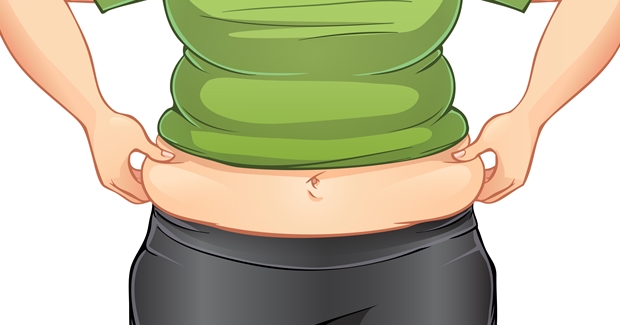When you’re at an ideal weight, the hormones and chemicals secreted by fat cells are actually healthy. The problem arises when you have more and larger fat cells than normal, which often occurs in an individual who is overweight. Both traditional medicine and modern medicine agree on the fact that excess belly fat is the primary root cause of many serious health problems including hypertension, diabetes, and chronic inflammation.
Here are some pointers on the types of belly fat, and what you can do to keep them in check.
Subcutaneous Fat
We tend to be most bothered about subcutaneous fat – fat that accumulates below the skin all over the body but more generously around our waist, thighs and hips. This fat is visible to the eye, plays havoc with our body shape and an eye sore – which all of us want to get rid of as quickly as possible. However, subcutaneous fat is relatively harmless, from a health risks perspective. The urge to get rid of it has more to do with social and cultural mores – in any case, not all cultures look down upon those who look fat, and these perceptions tend to change over time too.
If you are able to walk, run, climb up stairs, play some sports, dance, sleep well, and are free from infections and diseases – in other words, if you are healthy – you don’t need to worry about subcutaneous fat. You can always put in some hours of exercise to tone your body, if you really want to.
Low Belly Fat
The soft stomach in the lower abdomen is usually associated with a sedentary life style and minor digestive issues. If you are otherwise lean, but are seeing a gradual increase in girth (the pants are getting tighter), low belly fat is probably what you have. While not a grave cause for concern, best to nip it in the bud.
Include regular moderate-intensity exercise and add digestive herbs to your diet. Often, the results show up very quickly – within a few days or at most a few weeks, depending on your body type and metabolic profile.
Punctured Tire Belly Fat
The pronounced fat bulge around the waist occurs mainly due to a prolonged sedentary life style and unbalanced diet leading to obesity. You know you have a punctured tire belly if – well, how can you miss it?
You will have to say a staunch NO to processed and fried foods, sugar, alcohol and sodas and keep a tab on food portions. Include regular moderate-intensity exercise in your daily schedule and switch to a weight-control diet consisting of whole grains, beneficial fats (poly-unsaturated fats and medium chain saturated fats), lean proteins, essential minerals and vitamins. Progress can be slow and sometimes unsteady – there might be periods where there is no visible impact on weight or girth and then some periods where there are sudden changes – stick to your plan nevertheless.
Visceral Abdominal Fat
While subcutaneous fat is an eye sore, its the invisible kind of fat that’s much more dangerous. Visceral Abdominal Fat (VAF), occupies the spaces between the abdominal organs. VAF has been linked to impairment of glucose and lipid metabolism leading to glucose intolerance, elevation of lipid levels, hypertension, insulin resistance, cardiovascular disease and type 2 diabetes. Metabolic risk factors of VAF are even higher for obese people – those with high amount of subcutaneous fat may have a high amount of VAF as well.
Excess visceral fat is possibly more harmful because of its proximity to the portal vein, which carries blood from the intestinal area to the liver. Substances released by visceral fat, including free fatty acids, enter the portal vein and travel to the liver, where they can influence the production of blood lipids leading to an increase in metabolic disturbances and risk factors.
From clinical and basic investigations, aging, sex hormones, excess intake of sucrose and lack of physical exercise have been suggested to be determinants for visceral fat accumulation.3 Studies have also shown an association between uncontrollable stress and abdominal fat distribution, especially in women.
If your shirts are getting tighter (around the upper abdomen area) or if it is more of an ordeal to climb stairs (or jog around the park), you must seriously consider the possibility of accumulation of VAF.
Stop skipping meals, quit junk food, eat a balanced nutritious diet, have smaller portions, avoid emotional eating, limit caffeine and alcohol intake, avoid smoking, include moderate-intensity exercise and most importantly – practice deep breathing and meditation. Progress is usually slow and steady and the results can manifest in multiple ways beyond weight and girth reduction – easier digestion, better stamina, better sleep etc.
Bloated and Distended Belly
While bloating (feeling full) and distension (temporary increase in abdominal girth) are not related to belly fat, they are indications of digestive disorders which may eventually lead to belly fat. They are usually caused by excess gas production, and/or disturbances in the movement of the muscles of the digestive system.5 Bloating and distension often follow cyclic patterns – most intense after meals, especially if the gap between meals is high, less intense when lying down and improve overnight.
In this case, you do not need excessive exercise but a balanced diet including foods and herbs that assist and regulate digestion and possibly elimination of specific foods (such as dairy, gluten etc.) from your diet that might be causing or aggravating the problem.
